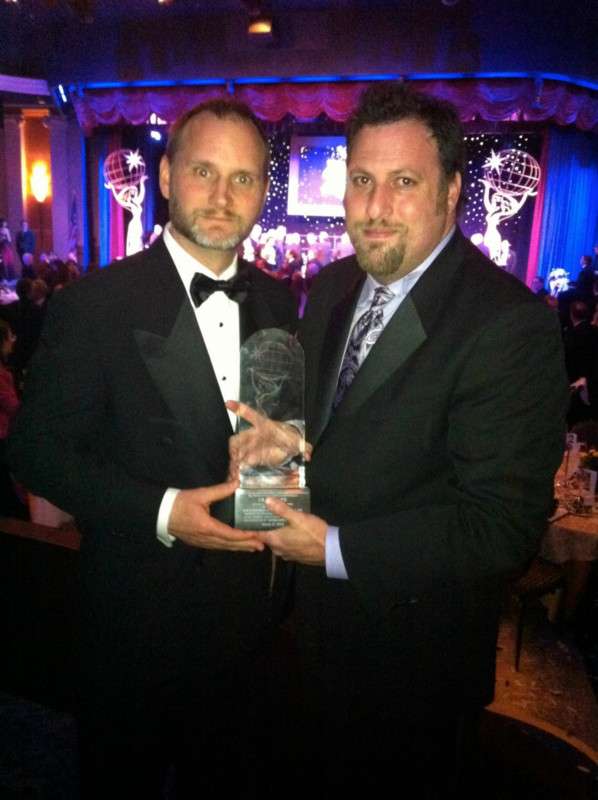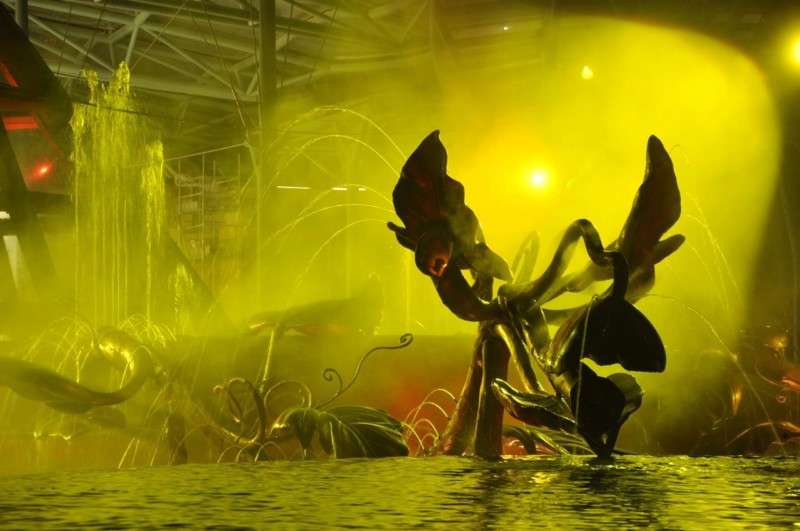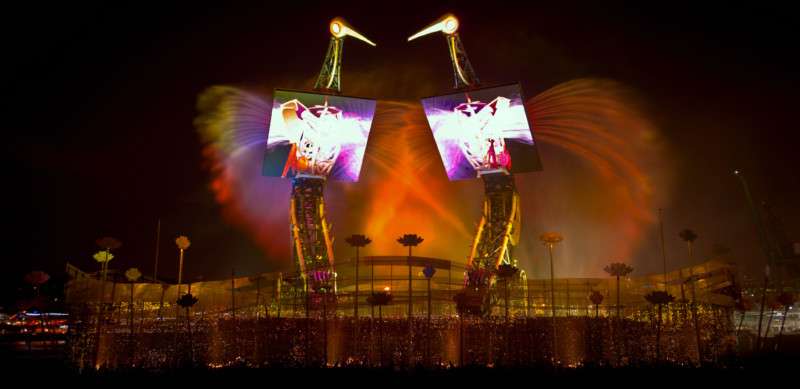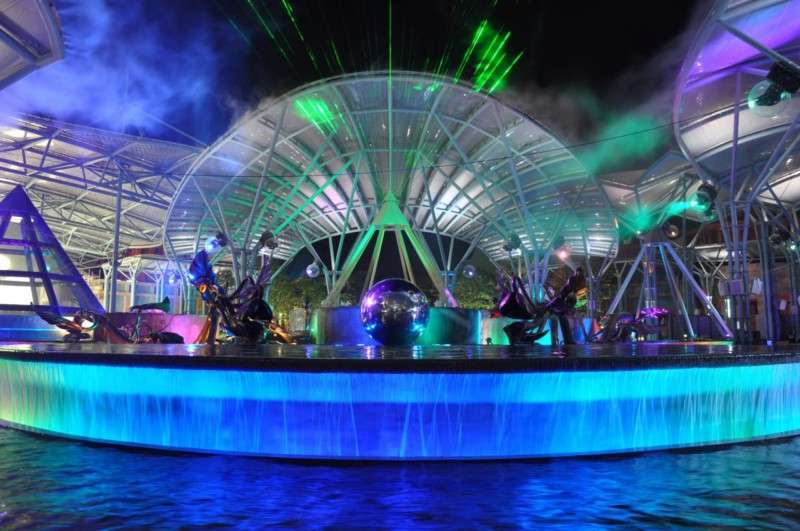The Producers Group talks about project production at Resorts World Sentosa
By Judith Rubin
ABOVE PHOTO: Lake of Dreams combines water effects, lasers, lighting and technology to create an inspiring show. Photo courtesy of The Producers Group
The Producers Group (TPG) defines itself as a company specializing in one-off visitor attractions, and has distinguished itself on several large, recent projects in Asia. TPG endeavors to supply “everything but the creative,” and to manage the lot. In the themed entertainment industry, creative management teams are often headed by designers, so theirs is a non-traditional approach. But TPG principals Bob Chambers and Edward Marks maintain that the 21st century visitor attraction, rich in technology, rich in storytelling and frequently in Asia, demands a producer-centric development model to be realized in a robust manner, adhere to schedule and budget, and protect the integrity of the designer’s vision.
While many, if not most of today’s projects rely on equipment that is available off the shelf, those pieces of sophisticated gear are being put together in novel, bleeding edge configurations that challenge designers and producers to the limits of feasibility. At the same time, production timelines and budgets for these custom attractions are often pared to the bone. Here are two tales from the front lines of production.
Note: The projects described here preceded the formal creation of TPG in 2011. It was on the basis of these and similar collaborations that Chambers and Marks decided to found the company. For simplicity, the Chambers and Marks team is referred to throughout as TPG.

Programming in the midst of construction
Lake of Dreams at Resorts World Sentosa
Designer: Entertainment Design Corp. (Jeremy Railton)
Client: Resorts World Sentosa, Singapore
TPG staff’s role: Owner’s Representation, Project Management, Technical Design and Management, Oversaw Construction and Installation, Client Contract Management, Vendor Contract Management, Complete Production Services
What happens when show production must move forward and the installation hasn’t attained the dust-free conditions that protect sensitive gear? Says Edward S. Marks, co-CEO of The Producers Group, “If we don’t get our dustfree environment at the appointed time, we erect a programming tent. It allows us to remain productive and do what needs to be done to honor the opening date.”
Lake of Dreams is a dramatic, musical extravaganza featuring multidimensional laser effects, high-powered water cannons and two fire breathing dragons. The 15-minute nightly show is set up in an outdoor amphitheater on a marble plaza between two hotel towers, above the basement-level casino at Resorts World Sentosa (RWS), near the entrance to Universal Studios Singapore. It entertains people of all ages, often in family groups.
TPG set up an elevated work tent outdoors to commence programming and other tasks in the thick of construction. Resembling a sportscaster’s nest, the 25’ x 25’ tent was designed and positioned on a 3-tiered, standalone platform with movable jacks to obtain the correct sightlines. It was a functioning office running on temporary power: staired, carpeted and airconditioned, with computer equipment and Internet access, cable drops for each vendor’s needs, a meeting room, craft services, and security. The front was of clear plastic. “We get input from various disciplines and draw up a wiring diagram and programming hierarchy to make sure everybody has what they need,” explains Marks.
Lake of Dreams was one of three shows designed by Railton for Resorts World Sentosa; the other two are Crane Dance and the Hall of Treasures. Brought in by Railton, TPG’s team (Edward Marks, Bob Chambers, Chris Homsley, Andrew Rubio and Rob Palmer) were responsible for budgets, schedules, vendor management and negotiations, client management and negotiations, overseeing the complete production and installation, and managing the design process. “The idea is to relieve the creative person – in this case, Jeremy – of the left-brain burden,” says Marks. Vendors included OASE (Water), ATECH (Scenic & Lighting), EAS (Audio & Video) and Patrick Woodroofe (Lighting Design).
Lake of Dreams needed to be open for RWS to obtain its gaming license, adding urgency to the project. Access paths and roads wouldn’t be finished for months, and the programming tent was raised amid unpaved earth and construction crews working on tiling, marble walls, landscaping and pipe-laying, with the attendant jackhammers, earth-movers, dust and noise. “Dialing the Lake into the middle of that was complicated as well as hazardous,” says Marks. “We had to negotiate for a spot where we could work and they could work. Hardhats, steeltoed boots and ear protection were part of the uniform.”

TPG would occasionally halt the construction workers in order to test all guest vantage points of the 360 degree show they were programming. “The only really effective thing to say is, ‘We’re going to run a show – do you want to see it?’” observes Marks. Other tests, such as for the high-powered lasers, required getting the crews out of the area altogether. “Every minute of every day is scheduled,” says Marks.
The programming in progress becomes a showand-tell opportunity for the client. “The show is coming together; the marketing & PR people start showing up; interviews start happening inside the tent,” notes Marks. “This is a time to carefully manage client expectations so they don’t think you are further along than you really are. The first 50% was done quickly, but then we hit the inevitable plateau: the painstaking effort of tweaking and focusing and timing for video, water jets, lighting and other elements. From the client’s perspective it may not seem like much is happening during that stage.”
Running tests has its risks. “The reason it’s a test is it doesn’t always work,” says Marks. “It can be great for building public awareness, but also a bit nerve wracking, especially with one-of-a-kind shows like this. So we work with management and the owner to try to find a realistic balance between what you can conceal, what you should conceal and what you can’t conceal. Once all the pieces are working, the client may clamor to start the opening party early. But that’s like wanting to open a theater before you’ve rehearsed the play. Having functional components isn’t the same as having a programmed show of actual content.”
Stressing the importance of on-site programming and mixing, Marks said, “Usually when we go into the field to program, the show exists in a virtual form. All the show motion has been written in virtual space. But that isn’t the same as moving real mass in real space. This is a critical aspect of a one-off project. Sometimes you come within inches of what happens in real space, but there will always be moments where something feels, sounds, or looks one way virtually and the other way in reality. You have to be able to adjust in real time, in the real space, and for that you need a setup on site.”
Marks continued, “In the case of audio, if you’ve mixed for headphones, you still have to make a mix in the real space. Lake of Dreams occupies a 360 degree space that has slight variations in sound depending on where you stand. During programming, acoustical conditions constantly evolved as the site acquired vegetation and buildings. This is why a composer needs to write music that is three-dimensional, with many elements and layers. You bring all the elements to the site, take it apart and move it around and adjust it and test it until it works. Similar steps are followed in video, lighting, and even animation: we even keep a render farm on standby from the booth.”
Marks continues, “Make no mistake: It is risky to mount a tent full of equipment in the middle of a construction site. A hardhat won’t save you from everything. But risk is inherent to our work: Financial risk, scheduling risk, and of course physical risk. Those are all heightened when the project is a one-off. But that’s what we do. Assuming risk is our business.”

Unification through communication
Crane Dance
Client: Resorts World Sentosa
Designer: Entertainment Design Corp. (Jeremy Railton)
TPG’s staff role: Owner’s Representation, Project Management, Technical Design and Management, Oversaw Construction and Installation, Onsite Lighting Design, Client Contract Management, Vendor Contract Management, Complete Production Services, Special Effects Design, Mechanical Systems Design
In honoring Crane Dance with a 2012 Thea Award, the Themed Entertainment Association (TEA) stated: “What weighs 160 tons, stands over 90 feet tall and is, well, in love? The two cranes that perform every evening at Sentosa Island in Singapore, located on a man-made island in the channel between Resorts World Sentosa and the Singapore mainland.” Open since December 2010, this multi-million dollar project stands nine stories high and weighs 500 tons, and is now under consideration by the Guinness Book of World Records for the title of “Largest Animatronics in the World.”
The vast scale of Crane Dance does not prevent it making a powerful emotional connection with audiences. “Through the use of ultrasophisticated computer and motion controls, similar to those used on Japanese bullet trains, the cranes move with a grace and precision that is patterned after the mating rituals of real cranes,” stated TEA. “Additional character and personality are expressed via specially designed digital eyes. Each 6-foot diameter eye can blink, squint and react. The enormous, flapping wings of each crane incorporate multiple jets of streaming water that spray thousands of gallons of sea water up to 40-feet in pulsing arcs. Accentuated with pyro, theatrical lighting and audio effects, this technical marvel crosses cultural boundaries and amazes guests of all ages.”
In August 2009, Crane Dance had gone out to bid, and independent vendors were producing technical design documents. “The problem was, they were not communicating,” says Producers Group co-CEO Bob Chambers.
Says Chambers, “This big piece of machinery was going to be a Frankenstein monster if we didn’t all get in a room together and organize the design tasks. We arranged multiple meetings with groups of vendors each week. We broke the project down into pieces above the deck – which included the crane itself, pieces below deck – which consisted of several rooms underneath for electrical, hydraulics and electronics, and pieces on the deck: pipes, cables, stuff running from one room to another.” TPG staff also scheduled and enforced a weekly project management meeting and an owner update meeting.
The five principal vendors attending these meetings with TPG staff were LYS, PH Hydraulics, EAS, ATECH and OASE. Over the course of 10 weeks, the interchange bore fruit and the design took shape. “Dialog and collaboration started to happen,” says Chambers. “The vendors would get a bunch of new tasks, but they’d also get answers to important questions. It’s a sequential, iterative process. Every time you change something it affects all the others.”
LYS was contracted to do the bearings and steel that formed the skeletal structure of the cranes. PH Hydraulics was responsible for the giant piston cylinders and their power source. “Unless those vendors were talking to each other, we weren’t getting anywhere,” explains Chambers. “The way you move the cranes is with big hydraulic hoses. There are stainless steel pipes in the ocean, 4” diameter rubber hoses, and 5k horsepower hydraulics. Some of the PH pieces are under the deck; the pipes came through the deck and up through the birds. Then there were the ‘drag chains’ or cable ladders. They come from the industrial world. If a big cable has to slide back and forth but a hose has to go through it, you need a linked ladder that the cables tie to that can bend and roll over on itself without the hoses getting pinched. At 6’ tall and 2’ thick, it was the biggest I have ever seen. The birds are so big and there are so many hoses, it’s like a drilling rig. The drag chains had to mount to the mechanical bird.”
Chambers continues, “Above the deck, there were such issues as how to route the cables and giant water hoses and how to get those up through the bird – routing some of those pieces was almost unimaginably challenging. There were control wiring, power for the head, video signals for the video screens on the chest and eye blinking. This added up to a combination of high power and sensitive electronics near one another.”
EAS was the overall AV show control vendor, and through them Panasonic had been contracted to supply the entire facility, so special arrangements had to be made, because Crane Dance required saltwater-proof, 26’ x 26’ outdoor digital screens of a certain resolution (32 mil) that were only available from Barco. “A video screen needs a frame, too – and in this case the frame was on the chest of a giant crane,” observes Chambers. “That takes a drawing, and then there are cables going to the screen – another example of how everything affects everything else.”
ATECH, the lighting and scenic vendor for RWS on the project, provided marine-rated lights on the structure of the cranes. “Those lights needed a place to mount, and their cables had to be routed all the way down the bird and into the lighting room: it affected the bird, the deck, and under the deck,” notes Chambers. OASE was the fountain vendor responsible for the mechanized water wings that create the cranes’ 125’ wingspans. “It used a giant, German made water manifold with a motorized, huge metal pivot the size of a desk, fed by 8” diameter hose or pipe, with a 1500 horsepower pump. That had to be integrated into the design at the same time as everything else.”
“We’re especially proud that this design challenge was met in 10 weeks,” says Chambers.
Of course, when a high-tech project is done well, the audience doesn’t pay much attention to the mechanical specifics, or think about how many weeks it took to build – they get lost in the story, as they are meant to do.”
These tales from the production front lines are meant to convey what it takes to realize a hightech, custom attraction so that the technology and equipment become transparent, and the designer’s vision is fulfilled. As TEA described, “The cranes dance, flap their watery wings and bless RWS guests with love, long life and good fortune.”
Current projects for TPG include Lights of Liberty for Historic Philadelphia Inc, “Killer Karaoke” for TruTV, and The Red Sea Astrarium for RGH Entertainment. Visit www.producers-group.com. • • •






